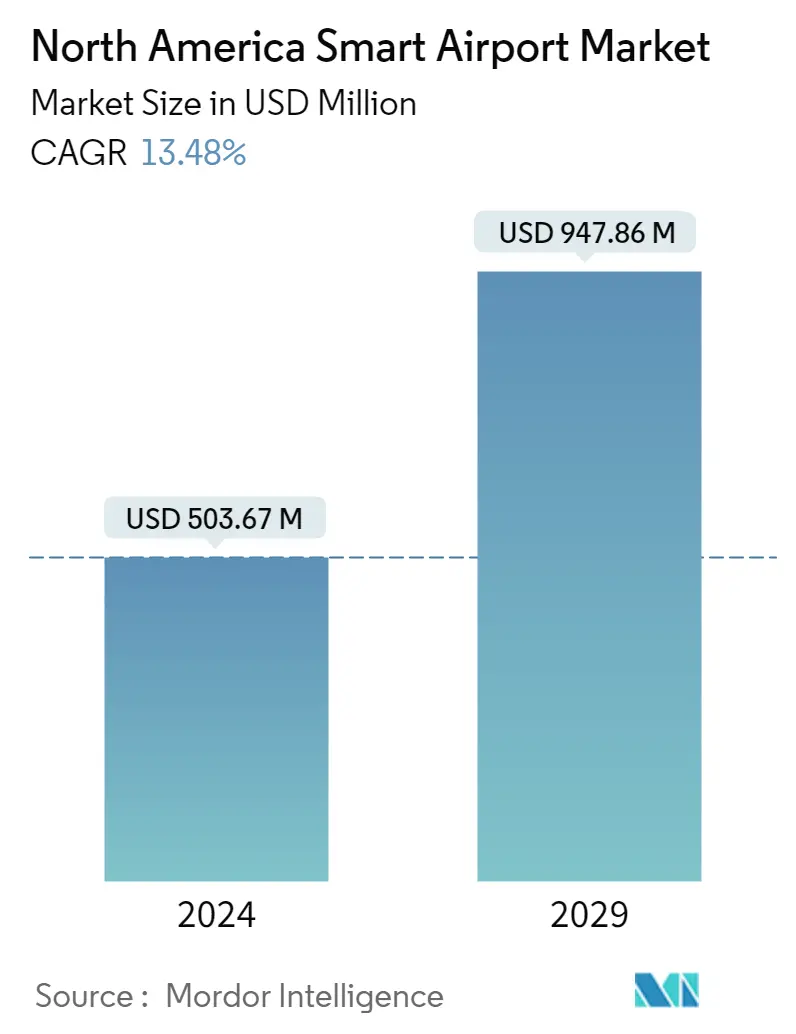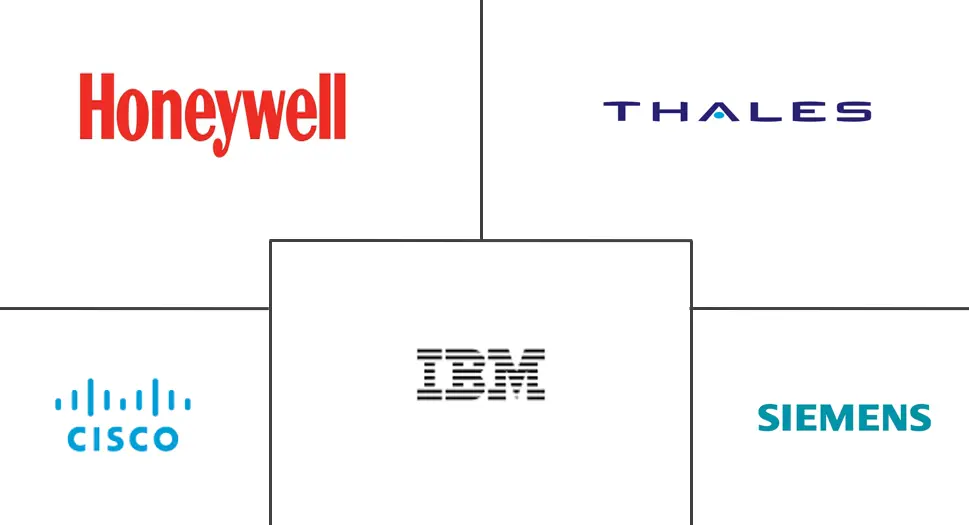Market Size of North America Smart Airport Industry

| Study Period | 2019 - 2029 |
| Base Year For Estimation | 2023 |
| Forecast Data Period | 2024 - 2029 |
| Market Size (2024) | USD 503.67 Million |
| Market Size (2029) | USD 947.86 Million |
| CAGR (2024 - 2029) | 13.48 % |
Major Players
*Disclaimer: Major Players sorted in no particular order |
North America Smart Airport Market Analysis
The North America Smart Airport Market size is estimated at USD 503.67 million in 2024, and is expected to reach USD 947.86 million by 2029, growing at a CAGR of 13.48% during the forecast period (2024-2029).
The COVID-19 pandemic has severely impacted the global aviation industry. The adverse impacts of the pandemic resulted in huge supply-demand issues and delayed activities of smart airport operations globally. The airlines faced unmatched challenges due to travel restrictions and a reduced number of air passengers which resulted in a decline in revenues. The market showcased a strong recovery post-COVID due to increased investment in the digitalization of airports.
The smart airport concept became the future of airport operations, and it can completely change the aviation sector toward adapting to modern technologies. The number of people opting for air travel has increased in the past few years which has resulted in increased pressure on airports and airlines to opt for advanced systems that can enhance their ground operations and support their motive to reduce aircraft turnaround time. Smart airport systems also provide numerous advantages such as they reduce physical human work, speeding up airport operations, and minimizes the environment's negative impact.
Increasing automation of the system is expected to revolutionize the entire process flow architecture in airports. Airports are using technologies such as artificial intelligence (AI) and predictive analysis for a wide range of applications, from customer service to operational efficiency.
North America Smart Airport Industry Segmentation
Smart airports are designed to integrate several data channels, including Wi-Fi and 4G, to allow for unified cloud-based communications, video, Internet of Things (IoT), and big data platforms. Smart airports use an array of technologies to improve their efficiency and connectivity, ranging from integrated sensors for monitoring temperature and lighting, smart baggage tags for tracking and directing luggage to the aircraft, biometric check-ins with facial recognition, and cargo warehousing management.
The North American smart airport market is segmented by technology and country. By technology, the market is segmented into security systems, communication systems, air/ground traffic control, and passenger, cargo, and baggage control, ground handling systems. By airport location, the market is segmented into the landside, airside, and terminal side, and by geography, the market is divided into the United States and Canada.
The report offers the market size and forecasts by value (USD million) for all the above segments.
| Technology | |
| Security Systems | |
| Communication Systems | |
| Air/Ground Traffic Control | |
| Passenger, Cargo and Baggage Control, and Ground Handling Systems |
| Airport Location | |
| Landside | |
| Airside | |
| Terminal Side |
| Geography | |
| United States | |
| Canada |
North America Smart Airport Market Size Summary
The North American smart airport market is poised for significant growth, driven by the increasing need for advanced technologies to enhance airport operations and passenger experience. The concept of smart airports is transforming the aviation sector by integrating modern technologies such as artificial intelligence and predictive analytics to streamline operations, reduce turnaround times, and minimize environmental impact. The market is recovering robustly post-COVID-19, with substantial investments in digitalization and automation. This transformation is essential as air travel demand rises, placing greater pressure on airports to adopt systems that improve efficiency and connectivity. The air and ground traffic control segment is expected to experience notable expansion, supported by increased spending on airport modernization in the United States and Canada.
The United States holds a dominant position in the North American smart airport market, benefiting from significant investments in aviation infrastructure and the highest number of airports. Initiatives like the FAA's funding for air traffic control system modernization and the expansion of IoT-powered systems are key drivers of market growth. However, the market is highly consolidated, with a few major players like Cisco Systems Inc., Honeywell International Inc., and IBM Corporation holding substantial shares. The stringent regulatory environment and economic conditions in the US influence the adoption of technology-based platforms, potentially slowing market growth during economic downturns. Despite these challenges, ongoing advancements in technology and infrastructure are expected to sustain the market's expansion trajectory.
North America Smart Airport Market Size - Table of Contents
-
1. MARKET DYNAMICS
-
1.1 Market Overview
-
1.2 Market Drivers
-
1.3 Market Restraints
-
1.4 Porter's Five Forces Analysis
-
1.4.1 Threat of New Entrants
-
1.4.2 Bargaining Power of Buyers/Consumers
-
1.4.3 Bargaining Power of Suppliers
-
1.4.4 Threat of Substitute Products
-
1.4.5 Intensity of Competitive Rivalry
-
-
-
2. MARKET SEGMENTATION
-
2.1 Technology
-
2.1.1 Security Systems
-
2.1.2 Communication Systems
-
2.1.3 Air/Ground Traffic Control
-
2.1.4 Passenger, Cargo and Baggage Control, and Ground Handling Systems
-
2.1.5
-
-
2.2 Airport Location
-
2.2.1 Landside
-
2.2.2 Airside
-
2.2.3 Terminal Side
-
-
2.3 Geography
-
2.3.1 United States
-
2.3.2 Canada
-
-
North America Smart Airport Market Size FAQs
How big is the North America Smart Airport Market?
The North America Smart Airport Market size is expected to reach USD 503.67 million in 2024 and grow at a CAGR of 13.48% to reach USD 947.86 million by 2029.
What is the current North America Smart Airport Market size?
In 2024, the North America Smart Airport Market size is expected to reach USD 503.67 million.

